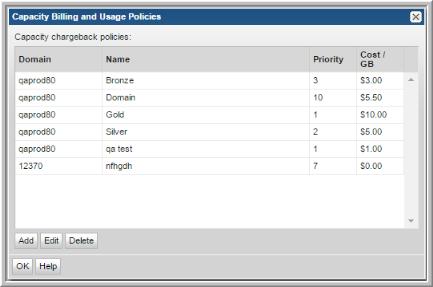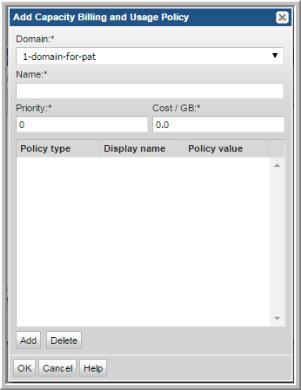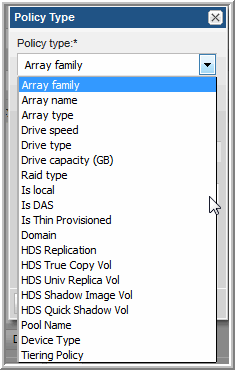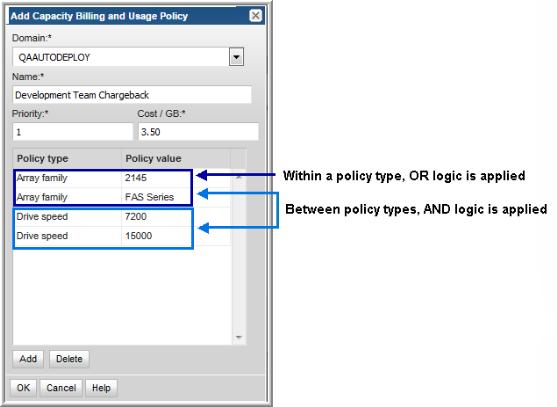Adding/Editing a Capacity Billing and Usage Policy
Capacity Billing and Usage Policies for chargeback can be configured to allocate costs for storage array usage. Costs can be associated with a variety of storage elements to enable a detailed approach to usage costs. The values that you configure in the Capacity Billing and Usage Policies for chargeback are used by the following reports:
• Aggregated Chargeback
• Chargeback Array Capacity
• Chargeback By Host
• Chargeback Policy Capacity
Note: Capacity Chargebacks can be configured for block storage only; file-based storage is not supported for Array Capacity Chargeback.
To add/edit a capacity chargeback policy
1. Select Admin > Chargeback > Capacity
2. Click Add to add a new policy or select an existing policy and click Edit.
The following window launches, where you’ll define the Policy Type and other chargeback policy attributes.
3. Configure the following elements:
Note: An asterisk (*) denotes a required entry.
Domain | Select a domain. Typically, only one domain is listed, unless the portal is maintained by a Managed Services Provider (MSP). |
Name | Enter a name for the policy. |
Priority | • Priority - 1 is the highest priority • If a LUN subscribes to two chargeback policies with the same priority, two LUNs will be listed in the capacity chargeback reports. |
Cost/GB | Enter the cost associated with this capacity billing and usage policy. |
4. Click Add to select a Policy Type.
Capacity Chargeback Policy Types
One or more policy types comprise a Capacity Chargeback Policy, as described in this section. Policy Types can be combined to provide “or” logic. If two or more of the same policy types are configured in a policy, the conditions will be “ORed” when the Portal evaluates the policy during report generation. Conditions
within the same policy type are joined by OR, while AND logic is used
between policy types. See
Example of Capacity Billing and Usage Policy Logic.
Note: Capacity Chargebacks can be configured for block storage only; file-based storage is not supported for Array Capacity Chargeback.
The following procedure is the second part of configuring a Capacity Chargeback Policy, as described in
Adding/Editing a Capacity Billing and Usage Policy.
6. Select Admin > Chargeback > Capacity
7. Click Add.
8. In the Policy Type window, select a Policy type and one or more Policy values from the drop-down list.
• Policy Types include: Array Family, Array Name, Array Type, Drive Speed, Drive Type, Drive Capacity (GB), RAID Type, Is Local, Is DAS, Is Thin Provisioned, Domain, HDS Replication, HDS True Copy Vol, HDS Univ Replica Vol, HDS Shadow Image Vol, HDS Quick Shadow Vol, Pool Name, Device Type, and Tiering Policy. See also,
Drive Types for Capacity Chargeback.
• For EMC Arrays, Device Type should be used instead of RAID Type for LUN mapping.
• Capacity Chargeback Policies can be configured for thin-provisioned storage pools for: HP USP and USP-V Dynamic Pools, CLARiiON and Symmetrix Thin Pools, and IBM XIV. To configure this in a Capacity Chargeback Policy, select Pool Name.
• Capacity chargeback policies support virtualized storage. Supported virtualized storage systems include Hitachi Virtual Storage Platform (VSP), Hitachi NAS, EMC VPLEX, IBM SVC, NetApp 7-Mode, and NetApp Cluster Mode. The chargeback policy (drive speed, drive type, drive capacity, and RAID type) uses characteristics of the back-end arrays’ LUNs, where the physical disks for the LUNs actually reside, to automatically categorize the LUN into the correct storage tier.
• These HDS Capacity Chargeback Policies—HDS True Copy Vol, HDS Univ Replica Vol, HDS Shadow Image Vol, HDS Quick Shadow Vol—augment the HDS Replication policy, enabling flexibility for policies to cover various combinations of configurations.
Note: Policy types are applicable to specific arrays and therefore, not all policy types will be listed in your Portal. For example, the Tiering Policy type is available only for the following arrays: Hitachi NAS (HNAS), EMC Symmetrix Fast, and Compellent.
9. Click OK to save the configuration.
The values that appear in the Policy Value drop-down list are derived from your existing database. However, in anticipation of new storage resources for which data will be collected, you can enter values.
Array Family | Select an Array Family from your environment, or enter a name. |
Array Name | Select an Array Name from your environment, or enter a name. |
Array Type | Select an Array Type from your environment, or enter a name. |
Device Type | Select a type; for example, 2-Way BC Mir (Meta Head, Non-Exclusive Access) or RAID-5 (non-Exclusive Access). |
Domain | Capacity Billing and Usage Policies are domain-specific. Therefore, this policy type would rarely be used. The intent of this policy type is to provide the capability for a “catch-all” rule to cover all objects in a domain. |
Drive Capacity (GB) | Select a Drive Capacity for drives in your environment, or enter a size. Drive Capacity is treated as a range of values—that is, the value entered here plus or minus the value that is configured as a system parameter. The default value set in the system parameters is 10 GB. Advanced Configuration: To modify the drive capacity range, enter a value here and in the system parameters, provide a value that indicates a range; for example, 320 plus or minus 50. Search the online documentation for Configuring System Parameters. |
Drive Speed | Select a Drive Speed for drives in your environment, or enter a speed. |
Drive Type | Select a Drive Type from your environment, or enter a type. See Drive Types for Capacity Chargeback. The display name is associated with an internal policy value. Several policy display names translate to the same internal value. For example, 5-SSD and 8-FMD both translate to a value of SSD. In this example, if you attempt to add both policy display names to the chargeback policy, only one will be retained since they are duplicates of the same value. |
HDS Quick Shadow Vol | P-VOL, POOL, Simplex, V-VOL |
HDS Replication | JNL-VOL, MF-JNL, P-VOL, POOL, S-VOL, SP-VOL, Simplex, Unknown, V-VOL. |
HDS Shadow Image Vol | P-VOL, S-VOL, Simplex |
HDS True Copy Vol | P-VOL, S-VOL, Simplex |
HDS Univ Replica Vol | JNL-VOL, MF-JNL, P-VOL, S-VOL, Simplex |
Is DAS | Direct-attached Storage: Yes or No |
Is HDT | Is Hitachi Dynamic Tiering enabled: Yes or No. When Yes, this associates LUNs to HDT pools, to enable distinct and separate chargeback rates. |
Is Local | This policy type applies to virtual array scenarios (for example, Hitachi virtual arrays), where back-end arrays are feeding front-end arrays: Yes or No |
Is Thin Provisioned | Is thin provisioning enabled: Yes or No |
Pool Name | Select a storage pool from the list. |
RAID Type | Select a RAID Type from your environment, or enter a type. |
Tiering Policy | This policy type is available only for the following arrays: Hitachi NAS (HNAS), EMC Symmetrix Fast, and Compellent. Select a storage tiering policy value, such as Tier 0 (3090-Cluster), from the list. |
Repeat these steps to define additional Policy Types for a Capacity Chargeback Policy.
Example of Capacity Billing and Usage Policy Logic
Several policy types can be combined in a Capacity Billing and Usage Policy. Conditions within the same policy type are joined by OR, while AND logic is used between policy types.
The configuration shown in
Figure 15.1 Example of Capacity Chargeback Policy Logic translates to the following logic:
(Array family = 2145 OR Array family = FAS Series) AND (Drive speed = 7200 OR Drive Speed = 15000)
Figure 15.1 Example of Capacity Chargeback Policy Logic
Drive Types for Capacity Chargeback
The following table lists the drive types supported for each array vendor.
Vendor and Array | Drive Type Values |
Dell Compellent | FC, SAS, SSD |
EMC CLARiiON | Fibre Channel, SATA, SAS, ATA, SATAII, NL SAS, FC SSD, SATA Flash, SAS Flash |
EMC Isilon | SATA, SAS, SSD, Unknown |
EMC Symmetrix | FC, SATA, EFD, SAS. Select Dynamic - for multiple drive types of Storage Resource Pool (SRP). |
HDS | • 0:FC • 1:SATA • 2:BD • 4:SAS • 5:SSd • 7:SAS(SED) • 8:FMD • 9: FMC • Unknown FMD: Flash Module Drive SED: Self-encrypting drives SAS: Serial Attached SCSI FMC: Flash Module Compression (another name for the FMD DC2 drives) |
IBM 3-4K | Fibre Channel, Serial ATA (SATA), SAS |
IBM 6K | ENT, NL, FC, SSD, Volume, Unknown |
NetApp | FCAL, SATA, SAS, ATA, EATA, LUN, SCSI, XATA, XSAS, FSAS, BSAS, SSD, MSATA, Unknown |
NetApp Cluster-Mode | FCAL, SATA, SAS, ATA, EATA, LUN, SCSI, XATA, XSAS, FSAS, BSAS, SSD, MSATA, Unknown |
Note: Beginning with Release Version 9.2.01P5, EMC CLARiiON drive types include more granular values for Capacity Billing and Usage Policies, as listed in the following table.
EMC CLARiiON Drive | Former Value | Current Value |
FC SSD | SSD | FC SSD |
NL SAS | SAS | NL SAS |
SAS Flash | SSD | SAS SSD |
SATA Flash | SSD | SATA SSD |




